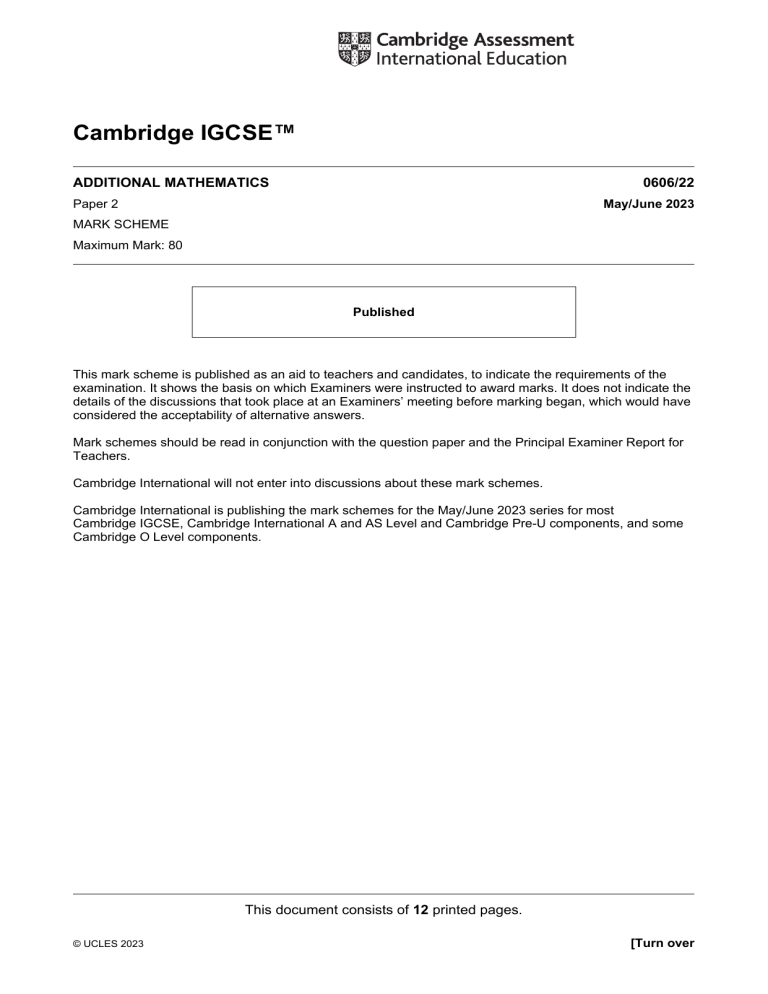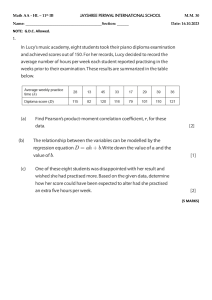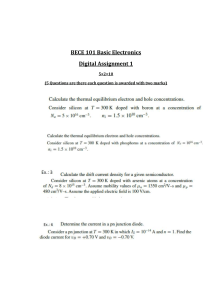
Cambridge IGCSE™ ADDITIONAL MATHEMATICS 0606/22 Paper 2 May/June 2023 MARK SCHEME Maximum Mark: 80 Published This mark scheme is published as an aid to teachers and candidates, to indicate the requirements of the examination. It shows the basis on which Examiners were instructed to award marks. It does not indicate the details of the discussions that took place at an Examiners’ meeting before marking began, which would have considered the acceptability of alternative answers. Mark schemes should be read in conjunction with the question paper and the Principal Examiner Report for Teachers. Cambridge International will not enter into discussions about these mark schemes. Cambridge International is publishing the mark schemes for the May/June 2023 series for most Cambridge IGCSE, Cambridge International A and AS Level and Cambridge Pre-U components, and some Cambridge O Level components. This document consists of 12 printed pages. © UCLES 2023 [Turn over 0606/22 Cambridge IGCSE – Mark Scheme PUBLISHED May/June 2023 Generic Marking Principles These general marking principles must be applied by all examiners when marking candidate answers. They should be applied alongside the specific content of the mark scheme or generic level descriptors for a question. Each question paper and mark scheme will also comply with these marking principles. GENERIC MARKING PRINCIPLE 1: Marks must be awarded in line with: the specific content of the mark scheme or the generic level descriptors for the question the specific skills defined in the mark scheme or in the generic level descriptors for the question the standard of response required by a candidate as exemplified by the standardisation scripts. GENERIC MARKING PRINCIPLE 2: Marks awarded are always whole marks (not half marks, or other fractions). GENERIC MARKING PRINCIPLE 3: Marks must be awarded positively: marks are awarded for correct/valid answers, as defined in the mark scheme. However, credit is given for valid answers which go beyond the scope of the syllabus and mark scheme, referring to your Team Leader as appropriate marks are awarded when candidates clearly demonstrate what they know and can do marks are not deducted for errors marks are not deducted for omissions answers should only be judged on the quality of spelling, punctuation and grammar when these features are specifically assessed by the question as indicated by the mark scheme. The meaning, however, should be unambiguous. GENERIC MARKING PRINCIPLE 4: Rules must be applied consistently, e.g. in situations where candidates have not followed instructions or in the application of generic level descriptors. GENERIC MARKING PRINCIPLE 5: Marks should be awarded using the full range of marks defined in the mark scheme for the question (however; the use of the full mark range may be limited according to the quality of the candidate responses seen). GENERIC MARKING PRINCIPLE 6: Marks awarded are based solely on the requirements as defined in the mark scheme. Marks should not be awarded with grade thresholds or grade descriptors in mind. © UCLES 2023 Page 2 of 12 0606/22 Cambridge IGCSE – Mark Scheme PUBLISHED May/June 2023 Maths-Specific Marking Principles 1 Unless a particular method has been specified in the question, full marks may be awarded for any correct method. However, if a calculation is required then no marks will be awarded for a scale drawing. 2 Unless specified in the question, answers may be given as fractions, decimals or in standard form. Ignore superfluous zeros, provided that the degree of accuracy is not affected. 3 Allow alternative conventions for notation if used consistently throughout the paper, e.g. commas being used as decimal points. 4 Unless otherwise indicated, marks once gained cannot subsequently be lost, e.g. wrong working following a correct form of answer is ignored (isw). 5 Where a candidate has misread a number in the question and used that value consistently throughout, provided that number does not alter the difficulty or the method required, award all marks earned and deduct just 1 mark for the misread. 6 Recovery within working is allowed, e.g. a notation error in the working where the following line of working makes the candidate’s intent clear. © UCLES 2023 Page 3 of 12 0606/22 Cambridge IGCSE – Mark Scheme PUBLISHED May/June 2023 MARK SCHEME NOTES The following notes are intended to aid interpretation of mark schemes in general, but individual mark schemes may include marks awarded for specific reasons outside the scope of these notes. Types of mark M Method marks, awarded for a valid method applied to the problem. A Accuracy mark, awarded for a correct answer or intermediate step correctly obtained. For accuracy marks to be given, the associated Method mark must be earned or implied. B Mark for a correct result or statement independent of Method marks. When a part of a question has two or more ‘method’ steps, the M marks are in principle independent unless the scheme specifically says otherwise; and similarly where there are several B marks allocated. The notation ‘dep’ is used to indicate that a particular M or B mark is dependent on an earlier mark in the scheme. Abbreviations awrt cao dep FT isw nfww oe rot SC soi answers which round to correct answer only dependent follow through after error ignore subsequent working not from wrong working or equivalent rounded or truncated Special Case seen or implied Question 1(a) 1(b)(i) Answer Marks Partial Marks 3x 2 15 x 12 [* 0] oe where * is any inequality sign or = B1 Factorises or solves their 3-term quadratic M1 FT their 3-term quadratic x < 1 or x > 4 mark final answer A1 3 x 2 4 3 B2 for 3 x 2 2 2 or B1 for x 2 or a = 3, b = –2 2 and B1 for a x b 4 with numerical 2 values of a and b or c = 4 1(b)(ii) © UCLES 2023 y = their 4 B1 STRICT FT their 4 from part (i) Page 4 of 12 0606/22 Cambridge IGCSE – Mark Scheme PUBLISHED Question 2(a) Answer May/June 2023 Marks Partial Marks B2 dy 2 x 3 64 x oe, isw dx 8 dy 64 x kx 3 or dx dy 2 x 3 kx where k is a non-zero dx 8 B1 for constant or SC1 for their dy 2 64 x x 3 c dx 8 M1 FT their derivative providing it has two terms and at least one term is a correct power of x dy = 0 and attempt to solve dx A2 A1 for either stationary point correct or for x = 0.25 nfww (0.25, 4), (0.25, 4) nfww, isw or, if dy 64 x 16 x 3 , then award dx 1 65 SC2 for , oe or 2 4 SC1 for either of these stationary points or x © UCLES 2023 Page 5 of 12 1 2 oe 0606/22 Cambridge IGCSE – Mark Scheme PUBLISHED Question 2(b) Answer Marks Correct second derivative: M1 2 d y 3 64 x 4 oe, isw 2 dx 4 4 4 dy = mx nx 3 where m 0 dx A1 dep on x = 0.25 or x = –0.25 nfww in part (a) for correctly showing or stating d2 y 3 64 4 is positive 2 dx 4x 4 3 1 3 1 64 256 or 64 0 4 4 4 4 or d2 y d2 y 256 0 oe or when x = 0.25 dx 2 dx 2 and minimum [points] oe OR d2 y 3 64 4 and this is positive for any 2 dx 4x value of x and minimum [points] © UCLES 2023 FT their A2 dep on x = 0.25 nfww in part (a) OR 3(a) Partial Marks and n 0 seen in part (a) 31 31 64 = 256 or 64 > 0 4 4 4 4 or d2 y d2 y 256 0 oe when x = 0.25 or dx 2 dx 2 and minimum [points] oe 4 May/June 2023 12 – 69 + 27 + 54 = 0 B1 Page 6 of 12 0606/22 Cambridge IGCSE – Mark Scheme PUBLISHED Question 3(b) Answer Marks 10 x 7 2 x3 3x 2 33x 5 oe, soi M1 Uses the correct factor x + 3 to find a quadratic factor of the polynomial from part (a) oe with at least 2 terms correct M1 2 x 2 9 x 4 or 2 x 2 9 x 4 A1 Factorises or solves their 3-term quadratic factor = 0: May/June 2023 Partial Marks DM1 dep on previous M1 (2 x 1)( x 4) or (2 x 1)( x 4) or (2 x 1)( x 4) oe x = 3, x = 0.5, x = 4 nfww A1 dep on at least M0 M1 A1 DM1 awarded A(3, 23), B(0.5, 12), C(4, 47) oe and correct method to show mid-point e.g.: 3 4 23 47 1 , ,12 oe 2 2 2 B2 dep on x = 3, x = 0.5, x = 4 nfww 0.5 3 3.5 or AB and 12 23 35 4 0.5 3.5 BC oe 47 12 35 3 4 1 oe 2 2 and valid comment e.g. The points are collinear [so B is the mid-point of AC]. OR [x-coordinate mid-point] © UCLES 2023 Page 7 of 12 B1 dep on x = 3, x = 0.5, x = 4 nfww for A(3, 23), B(0.5, 12), C(4, 47) oe or [x-coordinate of the mid-point ] 3 4 1 oe 2 2 0606/22 Cambridge IGCSE – Mark Scheme PUBLISHED Question 4 Answer May/June 2023 Marks Partial Marks B2 must be seen dy sec2 (1 x) oe dx B1 for dy k sec2 (1 x) oe, k 1 dx or SC1 for dy sec2 1 x or dx dy sec2 (1 x) c dx Solves 3 2 tan(1 x) as far as 1 – x = tan–11 M1 π isw or 0.7853[98…] 4 π x 1 isw or 0.2146[01…] 4 A1 Correct use of chain rule and correctly writes in terms of cosine or tangent: their 1 0.04 oe, soi or π 2 cos their 4 M1 dep on at least B1 and an attempt to solve 3 2 tan(1 x) 1 x π their 1 1 tan 2 their 0.04 oe soi 4 5(a) 0.08 oe, nfww A1 dep on all previous marks awarded lg P lg A T lg b oe nfww B2 Must be seen and not from wrong working and correct comparison with y = mx + c soi 5(b) A = 106 oe isw and B1 for lg P lg A T lg b isw, nfww 4 B2 for A = 106 oe isw or B1correct method which could be used to find A e.g. 3 lgA = 6 or 12 = 14 lg A 7 3 7 b = 10 oe isw 3 B2 for b = 10 7 oe isw or B1correct method which could be used to find b e.g. lgb = © UCLES 2023 Page 8 of 12 12 6 oe or 12 = 14lg b 6 14 0 0606/22 Cambridge IGCSE – Mark Scheme PUBLISHED Question 5(c) Answer Marks May/June 2023 Partial Marks M1 If graph not used then allow M1 for substitution of their A and their b in the exponential equation as far as 108 109 (theirb)T and (theirb)T theirA theirA lg P1 = 8 and lg P2 = 9 soi leading to T1 = 4.6 to 4.8 or T2 = 6.8 to 7.2 OR substitution of their A and their b or their lgA and their lg b in the log equation lg108 their lg A T (their lg b) or better and lg109 their lg A T (their lg b) or better Difference of correct times: T2 T1 where T2 = 6.8 to 7.2 T1 = 4.6 to 4.8 M1 Answer in range 2.2 to 2.4 nfww A1 Alternative method Change in T = (M2) M1 for lg108 = 8 and lg109 = 9 and 98 3 7 Change in lg P 3 Change in T 7 (A1) Answer in range 2.2 to 2.4 nfww 6(a)(i) 5 10 1 x x2 7 49 B2 B1 for any two correct terms or for the three terms listed but not summed 6(a)(ii) 12 B2 6(b) 8 C4 k 4 (2) 4 [ x 4 ] oe or 1120k4 [x4] soi B1 8 C2 k 6 ( 2) 2 [ x 2 ] oe or 112k6 [x2] soi B1 1120k 4 5 70 16 k 4 5 oe, soi or 112k 6 8 28 4 k 6 8 M1 FT providing at least B1 awarded and correct terms attempted k 2 = 16 soi A1 [For coefficient of x to be positive k < 0, therefore] k = 4 A1 © UCLES 2023 Page 9 of 12 5 B1 for 7n + 5 = 89 or 7 n 89 oe 7 or n C1 12 0606/22 Cambridge IGCSE – Mark Scheme PUBLISHED Question 7(a) Answer 10(4 x 2) 4 3 (4 x 2)5 or Marks 10(4 x 2) 4 3 (4 x 2) isw 1 May/June 2023 Partial Marks 3 B2 for correct unsimplified form e.g. 1 1 4 3 (4 x 2)5 2 5 4 x – 2 4 2 5 2 or 1 10 3 (4 x 2)5 2 4 x – 2 4 or B1 for 5(4x – 2)4 4 soi 1 1 5 2 x 3 (4 2) or g( x) 2 7(b) dy 5(3x 2) 3(5 x) oe isw or dx (3 x 2) 2 dy 2 1 5 x 3x 2 3 5 3x 2 oe isw dx B1 [ y = 10] x = 0.8 B1 0.01 dy their oe δx dx x 0.8 M1 FT their x providing their x ≠ 10 or 0.01and their genuine attempt at a derivative using product or quotient rule 1 or 0.00016 or 1.6 104 isw 6250 A1 dep on all previous marks awarded Alternative method x 2 y oe 3y 5 dx 2(3 y 5) 3(2 y ) oe isw or dy (3 y 5)2 dx 2 1 2 y 3 y 5 3 (2) 3 y 5 dy (B1) δx dx oe their 0.01 dy y 10 (M1) FT their genuine attempt at a derivative using product or quotient rule 1 or 0.00016 or 1.6 104 isw 6250 (A1) dep on all previous marks awarded 7(c)(i) (B1) B2 B1 for (their 3x2)lnx + x3 (their 1 ) 3x2lnx + x3 1 or better, isw x © UCLES 2023 x Page 10 of 12 0606/22 Cambridge IGCSE – Mark Scheme PUBLISHED Question 7(c)(ii) Answer May/June 2023 Marks Partial Marks B3 must have arbitrary constant x3 ln x x 3 c oe, isw 6 18 x3 ln x x3 or 6 18 x 3 ln x kx3 +c, k > 0 nfww 6 3 B2 for or B1 for 1 6 1 3x ln x x dx 6 x dx soi x ln x x dx soi or 6 6 or 3 x ln x dx x ln x x dx soi x or 3x ln x dx x ln x soi 3 2 2 3 8 dy 1 x sin dx 4 4 M2 y = 0.5 B1 dy 1 3 3 or 4π dx x 4 2 8 M1 8 soi 3 M1 3 mnormal M1 for 2 2 2 3 2 3 2 3 dy 1 x k sin , k < 0 or k = 4 dx 4 FT (their k) 3 providing at least M1 2 awarded FT 1 dy their dx x 4π 3 y 0.5 A1 dep on previous M1; must have exact values 8 4π x oe 3 3 FT their mnormal and their 0.5 providing both are non-zero, exact values A1 4π 3 ,0 or exact equivalent; 3 16 mark final answer © UCLES 2023 Page 11 of 12 0606/22 Cambridge IGCSE – Mark Scheme PUBLISHED Question 9 Answer t t e 4 dt 4e 4 (c) and May/June 2023 Marks 16e 16e dt ( c) 2 t t Partial Marks B3 B2 for either correct or B1 for t t e 4 dt ae 4 (c) where a is a constant, a > 0 or 16e b t dt t (c) 2 where b is a constant b > 0 Correct plan: 4 t 4 e dt 0 M1 k 16e dt 13.4 soi 2 4 t A1 dep on B3; implies M1 Correct equation: 16e 16e 4e1 4e0 13.4 4 k OR [When t = 4 s = 4e – 4 When t = k s = 13.4 = 16e 8e 4 and] k 16e 8e 4 k k = 10 or awrt 10.0 10 A1 dep on all previous marks awarded B2 B1 for 2 c + b isw 5 c + kb where k 2c b c isw or B2 B1 for any of the following with n > 0 2c b n c or nc b c or b (2 )c isw or c b (1 )(nc b) or c b (1 )(c b) isw n c b (1 )(c b) Equates components at least once 2 2 or soi 5 2 and M1 FT providing of equivalent forms e.g.: sc + tb and xc yb z c where s, t, x, y, z are scalars A1 2 soi, nfww 5 A1 4 10 7 7 [AE : EB = ] 4 : 3 oe © UCLES 2023 2 or 1, k > 0 5 A1 must have earned all previous marks Page 12 of 12






